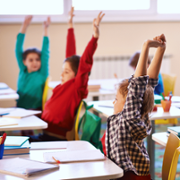5 Benefits of Physical Activity in the Classroom for Students
By Khaila Thomas | April 21, 2025
Physical activity is a vital component in the development of a person’s life. From adolescence to adulthood, moving our bodies throughout the day can have positive effects on our sleep quality, memory, bone health, and more. It’s essential to begin the habit of physical activity in childhood, which encourages lifelong healthy habits and helps meet the daily recommendation for adolescent physical activity.
Young people moving their bodies is crucial to their health and well-being, but only 20 to 28% of 6-17 year olds meet the 60 minutes of daily physical activity recommended by the U.S. Department of Health and Human Services (HHS) Physical Activity Guidelines for Americans. Schools and educators are in a unique position to help students meet these guidelines to achieve their best health.
Classrooms are not only a space to teach valuable skills, but to inspire healthy habits for a lifetime. Learn about the benefits of physical activity in class for students and resources to meet their needs.
1. Provides a boost in academic performance.
Physical activity can improve concentration, problem-solving, memory, and school attendance, which correlates with better grades and test scores in school. A study published in 2023 from the National Library of Medicine found that physical activity levels of over 90 minutes per week were associated with improved academic performance.
2. Maintains key functions of a healthy body.
Physical activity builds strong muscles, bones, and joints. It also improves cardiovascular health, which positively impacts blood pressure and blood sugar levels. Activity plays a vital role in young people managing their metabolism by increasing the number of calories they burn.
3. Releases mood-enhancing chemicals for overall brain health.
Physical activity releases endorphins, the brain’s feel-good chemicals while reducing the stress hormones, such as cortisol. For adolescents, moving their bodies can be an outlet for energy and emotions to reduce feelings of sadness, stress, and anxiety.
4. Fosters social development and communication skills.
Physical activity can further interpersonal connections through sports, group activities, and teamwork. These moments provide young people the opportunity to develop social skills and practice leadership, collaboration, and problem-solving as they interact with others.
5. Builds self-esteem, belonging, and confidence.
Physical activity provides room for achievement and athletic improvement. Whether that involves winning a competition, beating a personal best score, or being the fastest at a relay race—this increases self-esteem, sense of belonging, and the confidence to accomplish difficult tasks.
How Educators Can Incorporate Physical Activity in Class
Adding physical activity into the mix of education and day-to-day classroom activities has the benefits listed above and more. Not sure where to start as an educator? Check out this short list of items to try out before creating that next lesson plan!
- Ball tossing: With this activity, students can sit or stand in a circle while they take turns asking and answering questions, spelling, or learning new words. During this time, they will toss the ball to one another for everyone to take turns.
- Creative workstations or scavenger hunts: A simple yet interactive way to get students out of their seats. Hand out activity sheets and set up information-based workstations that lead them to each area around the class or school to find the answer. This can also foster collaboration and teamwork through problem-solving.
- Answer relays: While quizzing groups of students on previously learned information, break them into groups to see who can race the fastest to the front of the class and write the answer. Or have them write the answer on paper or a small whiteboard before they pass the item with the written answer up to the front of the class in a row. Whoever passes the right answer to the teacher the fastest is the winner!
- Trashcan basketball or soccer: This is a great activity for healthy competition! Students can be broken up into singles, pairs, or larger teams while they answer fact-based questions to score points. Whether you try this out with a basketball hoop or just a trash can and a crumbled-up piece of construction paper—students are bound to have fun while moving their bodies. Adding a defender ready to block the shot and take back points can make it more active!
- Mindful exercises: In between lessons or at the end of a school day, promote stretch breaks. This could be a fun time to try out yoga poses, deep breathing, and walking around the classroom to burn some energy from being sedentary.
Additional Resources for Physical Activity in the Classroom
B3: Brain, Body, Behavior: a multimedia curriculum that helps students in Grades K–6 spark their brains, build their bodies, and improve their behavior to increase academic performance. Want to test it out before a full purchase? View FREE items from B3 available for download.
HealthSmart Supercharging Lesson Cards: These colorful and laminated cards are ideal for getting students active throughout a lesson, promoting critical thinking, moving their bodies, and encouraging them to work collaboratively with their classmates. Check out a FREE 30-day preview of HealthSmart to see how they pair together!
Floor Graphics: Encourage the excitement of learning through play with our colorful sensory floor graphics. Great for problem-solving, creativity, balance, coordination, and motor skills. Use it in school hallways, gyms, classrooms, libraries, and more!
Khaila Thomas (she/her) is a Marketing and Communications Coordinator at ETR.




